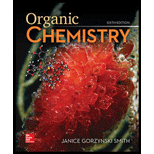
Concept explainers
(a)
Interpretation: The major product formed when given cycloalkane is heated with
Concept introduction: Free radicals are classified as
Halogens react with
(b)
Interpretation: The major product formed when given cycloalkane is heated with
Concept introduction: Free radicals are classified as
Halogens react with alkanes in presence of heat or light to form alkyl halides. This is known as halogenation reaction. This is a free radical substitution reaction. In this the halogen substitutes the hydrogen atom from
(c)
Interpretation: The major product formed when given cycloalkane is heated with
Concept introduction: Free radicals are classified as
Halogens react with alkanes in presence of heat or light to form alkyl halides. This is known as halogenation reaction. This is a free radical substitution reaction. In this the halogen substitutes the hydrogen atom from
(c)
Interpretation: The major product formed when given cycloalkane is heated with
Concept introduction: Free radicals are classified as
Halogens react with alkanes in presence of heat or light to form alkyl halides. This is known as halogenation reaction. This is a free radical substitution reaction. In this the halogen substitutes the hydrogen atom from
Want to see the full answer?
Check out a sample textbook solution
Chapter 13 Solutions
Study Guide/solutions Manual For Organic Chemistry
- Draw the mechanism to make the alcohol 2-hexanol. Draw the Mechanism to make the alcohol 1-hexanol.arrow_forwardDraw the mechanism for the formation of diol by starting with 1-pentanal in... basic conditions then acidic conditions then draw the mechanism for the formation of a carboxylic acid from your product.arrow_forwardIdentify each chiral carbon as either R or S. Identify the overall carbohydrates as L or Darrow_forward
- Ethers can be formed via acid-catalyzed acetal formation. Draw the mechanism for the molecule below and ethanol.arrow_forwardHOCH, H HO CH-OH OH H OH 11 CH₂OH F II OH H H 0 + H OHarrow_forwardDraw the mechanism for the formation of diol by starting with one pen and all in... basic conditions then acidic conditions then draw the mechanism for the formation of a carboxylic acid from your product.arrow_forward
 Organic Chemistry: A Guided InquiryChemistryISBN:9780618974122Author:Andrei StraumanisPublisher:Cengage Learning
Organic Chemistry: A Guided InquiryChemistryISBN:9780618974122Author:Andrei StraumanisPublisher:Cengage Learning
